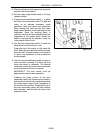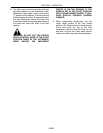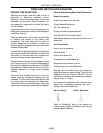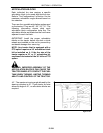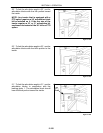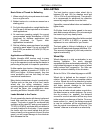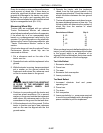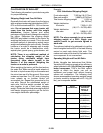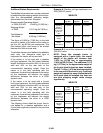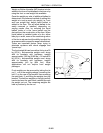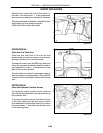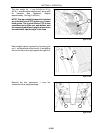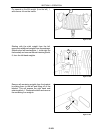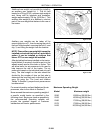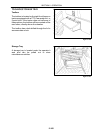
SECTION 2 - OPERATION
2-159
CALCULATION OF BALLAST
The following information is provided as a guide
for proper ballasting:
Shipping Weight and Fore/Aft Ratio
Generally the tractor will come from the factory
with an approximate weight distribution of 65% -
67% on the front axle and 33% - 35% on the rear
axle. Do not assume that every tractor will
come from the factory with this weight
distribution. Various options and wheel
packages will significantly change the weight of
the tractor. Determine the shipping weight
BEFORE any ballast is added to the tractor by
weighing the tractor on a scale. This is the most
accurate method of determining actual tractor
weight and ballasting the unit c orrectly. Possible
locations of a scale of adequate size to weigh
the tractor would be a feed/fertilizer store,
asphalt plant, gravel quarry, grain elevator, etc.
NOTE: There is an additional method of
calculating the shipping weight of the
tractor using calculated weight from
theoretical value charts located in the
Section 5 of this manual. Weighing the
tractor on a scale is preferred.
When weighing the tractor, pull the front axle on
the scale first. Make sure the inside wheels of
the dual or triple tires are fully on the scales and
the outer tires are off of the ground. Since most
scales are less than 3 m (10′) wide, driving the
inner wheels up on wooden blocks will
accomplish this. Repeat this procedure for the
rear axle. Record the unballasted weight of
each axle. Add the weight recorded for each
axle together to get a total tractor shipping
weight. Divide the individual axle weights by the
total tractor shipping weight to get the front to
rear weight distribution percentage.
Example:
2335 Unballasted Shipping Weight
Front axle weight: 7,265 kg (16,017 lbs.)
Rear axle weight: 3,966 kg (8743 lbs.)
Total tractor shipping weight: 11,231 kg
(24,760 lbs.)
Weight distribution
front axle: 7,265÷11,231
(16,017 ÷ 24,760)=65%
Weight distribution
rear axle: 3,966÷11,231
(8,743 ÷ 24,760)=35%
NOTE: The above example is not an exact
shipping weight of a 2335. Weigh your
specific tractor to get accurate figures to
work with.
The optimum ballast to be obtained is to get the
tractor weighted so that 50% of the load is being
carried on each axle during field work. This
makes each axle pull its share of the load so that
one component is not overworked.
Operating Weight and Fore/Aft Ratio
Buhler Versatile has determined that Buhler
Versatile 4WD tractors operate at top efficiency
when ballasted to 43.1 Kg (95 lbs.) per engine
brake horsepower. This is the total vehicle
weight at which the tractor can pull an
implement and propel itself without causing
excess soil compaction. The following chart
shows recommended operating weights based
on tractor model by horsepower at 43.1 Kg (95
lbs.) per horsepower ballast.
MODEL RATED
HORSEPOWER
RECOMMENDED
OPERATING
WEIGHT AT
95 LBS/HP
2290 290
12,500 kg
(27,550 lbs.)
2335 335
14,440 kg
(31,825 lbs.)
2360 360
15,515 kg
(34,200 lbs.)
2375 375
16,160 kg
(35,625 lbs.)
2425 425
18,315 kg
(40,375 lbs.)



